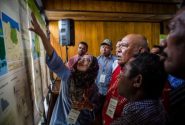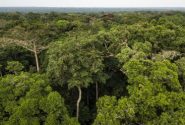
Beyond the trail: protecting roadless areas such as Marble Mountain Wilderness (pictured) in northern California, USA. Gary Robertson
DOHA, Qatar (7 December, 2012)_An international movement to protect the last remaining areas on earth that are ‘free from roads’ is gaining momentum, and experts say it may be one of the most cost-effective ways to slow deforestation, mitigate climate change and preserve biodiversity.
Kriton Arsenis, who is both the European Parliament’s Special Rapporteur on Forests and coordinator of global “roadless-ness” efforts, says the number of areas that remain free today of dusty tracks, streets or highways is rapidly shrinking.
“We need to act urgently if we want to protect biodiversity in a cost effective and economising way,” he said.
Road construction is widely known to be one of the biggest drivers of deforestation. By opening up access to previously inaccessible places, such as the heart of the Amazon rainforest, it allows for bulldozers and other heavy machinery to enter the region, leading to accelerated deforestation and “spider webs” of new roads and development throughout.
The uncontrollable human impact that has on resources prompted policymakers to launch the “roadless-ness” campaign at the Rio+20 summit in Brazil in July.
As floods of new migrants enter the region, social conflicts can also ensue as previously disconnected regions come into direct contact. Several studies have demonstrated a clear relationship between building roads and deforestation levels – deforestation increases near paved roads and drop off only at a distance of 45 kilometres on either side, found a recent CIFOR report.
Efforts to map the world’s roadless regions are already underway, starting with a series of interactive online maps developed by the European Environmental Agency, Google and the Society for Conservation Biologists. Now that we know where the world’s few roadless areas remain, the next step is to protect them, with these maps being used as tools for policy-making, says Arsenis, who presented the campaign at the Eleventh meeting of the Conference of the Parties to the Convention on Biological Diversity (COP 11) in Hyderabad India in October.
He says they will continue to build movement in the campaign throughout 2013, and in particular, will be targeting the world’s biggest financial institutions with their message.
“This is an issue that we see as important for any international development bank, such as the World Bank, and the International Development Bank: they have an important role to play because they have the choice to finance or not to finance new roads – without their support, roads cannot be built,” he said.
“Money is an important issue: we don’t have the necessary funds we need to protect biodiversity – instead of spending money to build new roads, perhaps we could allocate the missing finance for biodiversity projects and other kinds of development.”
Arsenis is keen to stress that campaigning against the construction of roads doesn’t equate to opposing development and economic growth as a whole.
“There are other ways of connecting people, such as railways and other more clearly managed infrastructures, which do not allow for the same easy transport of bulldozers and machinery,” he said.
“You can still have economic activity in roadless areas.”
There are some encouraging signs that the movement worldwide may gain momentum. In 2011 Bolivian President Evo Morales abandoned controversial plans to build a highway through the Tipnis reserve, after intense opposition to the project by indigenous campaigners from the region who feared an influx of illegal loggers, oil and gas companies, and coca growers.
The Tanzanian Government last year backed down from plans to build a tarmac road through the Serengeti National Park after studies showed it could seriously affect wildebeest and zebra migration patterns – although there are concerns work to upgrade the existing dirt track is still continuing.
But major road through the world’s last wild spaces continues: Construction continues on the Transoceanic Highway from Brazil to Peru, 6000 kilometers of asphalt that will eventually cut through the Amazon to connect ports with Brazil with ones in Peru.
Still, Arsenis is hopeful that the movement will grow, and says we can expect more from the coalition in the next year. “There are many small things we can do on the way to an international decision for the protection of roadless areas.”
For more stories from the UN climate talks in Doha, click here.
We want you to share Forests News content, which is licensed under Creative Commons Attribution-NonCommercial-ShareAlike 4.0 International (CC BY-NC-SA 4.0). This means you are free to redistribute our material for non-commercial purposes. All we ask is that you give Forests News appropriate credit and link to the original Forests News content, indicate if changes were made, and distribute your contributions under the same Creative Commons license. You must notify Forests News if you repost, reprint or reuse our materials by contacting forestsnews@cifor-icraf.org.










